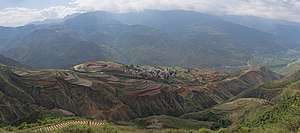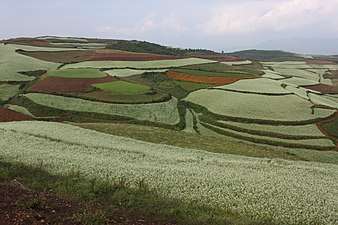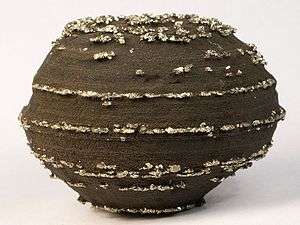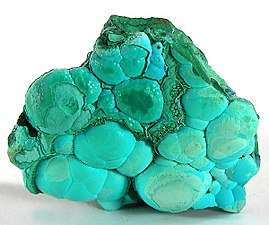Dongchuan District
| Dongchuan 东川区 | |
|---|---|
| District | |
 Luoxianggou | |
.png) Location of Dongchuan (pink) within Kunming (yellow), Yunnan (light grey) | |
 Dongchuan Location within China | |
| Coordinates: 26°11′N 103°04′E / 26.183°N 103.067°ECoordinates: 26°11′N 103°04′E / 26.183°N 103.067°E | |
| Country | People's Republic of China |
| Province | Yunnan |
| Prefecture | Kunming |
| Area | |
| • Total | 1,858 km2 (717 sq mi) |
| Population | |
| • Total | 302,000 |
| • Density | 160/km2 (420/sq mi) |
| Postal code | 654100 |
| Area code(s) | 0871 |
| Website |
www |
| Dongchuan District | |||||||||
| Traditional Chinese | 東川區 | ||||||||
|---|---|---|---|---|---|---|---|---|---|
| Simplified Chinese | 东川区 | ||||||||
| Literal meaning | East River District | ||||||||
| |||||||||
Dongchuan District[lower-alpha 1] is a district of and the northernmost county-level division of Kunming, the capital of Yunnan province, China.
History
Dongchuan was upgraded to a city in 1958. In 1998 Dongchuan was merged into Kunming and became one of its districts.
Geography
Dongchuan borders Sichuan.
The district's highest point, Jiaozi Snow Mountain, is 4330 meters high, and its lowest point is 695 meters. As of 2000 Dongchuan has a population of 275,564. As of 2006, the population was 302,000.[2]
The area around Huagou in the Wumeng mountains has become famous through photographers who discovered the unique local landscape and its Red Earth scenery in the 1990s.[3]
Administrative divisions
Copper Capital, A-wang, Wulong, Hongtudi, Tangdan, Tuobuka, Yinmin'ge Town and Shekuai Village
Climate
| Climate data for Dongchuan (1981−2010) | |||||||||||||
|---|---|---|---|---|---|---|---|---|---|---|---|---|---|
| Month | Jan | Feb | Mar | Apr | May | Jun | Jul | Aug | Sep | Oct | Nov | Dec | Year |
| Record high °C (°F) | 30.3 (86.5) |
33.0 (91.4) |
35.8 (96.4) |
37.9 (100.2) |
40.1 (104.2) |
38.5 (101.3) |
38.1 (100.6) |
37.3 (99.1) |
37.9 (100.2) |
33.9 (93) |
31.2 (88.2) |
29.7 (85.5) |
40.1 (104.2) |
| Average high °C (°F) | 19.9 (67.8) |
22.9 (73.2) |
27.0 (80.6) |
29.8 (85.6) |
30.3 (86.5) |
29.8 (85.6) |
30.0 (86) |
30.1 (86.2) |
27.9 (82.2) |
24.7 (76.5) |
22.7 (72.9) |
19.7 (67.5) |
26.2 (79.2) |
| Daily mean °C (°F) | 12.7 (54.9) |
15.7 (60.3) |
19.7 (67.5) |
22.8 (73) |
24.0 (75.2) |
24.4 (75.9) |
24.7 (76.5) |
24.3 (75.7) |
22.3 (72.1) |
19.2 (66.6) |
16.1 (61) |
12.6 (54.7) |
19.9 (67.8) |
| Average low °C (°F) | 7.0 (44.6) |
9.9 (49.8) |
13.6 (56.5) |
17.0 (62.6) |
19.1 (66.4) |
20.4 (68.7) |
21.0 (69.8) |
20.4 (68.7) |
18.5 (65.3) |
15.4 (59.7) |
11.2 (52.2) |
7.2 (45) |
15.1 (59.1) |
| Record low °C (°F) | −2.8 (27) |
−1.9 (28.6) |
−0.7 (30.7) |
5.9 (42.6) |
8.3 (46.9) |
13.0 (55.4) |
14.9 (58.8) |
14.5 (58.1) |
9.8 (49.6) |
7.5 (45.5) |
0.6 (33.1) |
−7.5 (18.5) |
−7.5 (18.5) |
| Average precipitation mm (inches) | 13.6 (0.535) |
11.4 (0.449) |
17.5 (0.689) |
24.6 (0.969) |
78.4 (3.087) |
153.4 (6.039) |
140.4 (5.528) |
103.1 (4.059) |
94.2 (3.709) |
71.7 (2.823) |
25.0 (0.984) |
8.0 (0.315) |
741.3 (29.186) |
| Average relative humidity (%) | 51 | 43 | 40 | 43 | 54 | 68 | 72 | 71 | 70 | 70 | 62 | 57 | 58 |
| Source: China Meteorological Data Service Center | |||||||||||||
Ethnic groups
Yi ethnic subgroups in Dongchuan are Black Yi 黑彝, White Yi 白彝, and Dry Yi 干彝 (Dongchuan City Gazetteer 1995:744). The Black Yi and Dry Yi speak Eastern Yi dialects, while the White Yi speak Chinese. Autonyms of Yi subgroups in Dongchuan are Nisepu 尼色普 and Gepu 戈普.
Other ethnic groups in Dongchuan are Miao (Big Flowery Miao 大花苗 subgroup), Hui, and Han (Dongchuan City Gazetteer 1995).
Economy
Dongchuan Special Industrial Park.[4]
The Dongchuan mineral resource is rich and it has one of six biggest coppers bases in China. It is verified that there are 3.35 million tons of copper, accounting for a third of the copper reserves in the province.[2]
|
Notes
References
Citations
- ↑ EB (1878), Vol. V, "China".
- 1 2 Kunming Pengcheng Trade Co. Ltd
- ↑ Dongchuan Red Soil at Chinatrekking
- ↑
Bibliography
External links
| Wikimedia Commons has media related to Minerals of Dongchuan District. |
- Dongchuan District Public Information Network - Official Website


